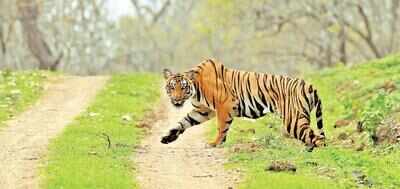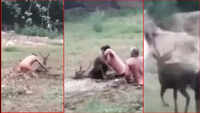
Nagpur: Scientists from Centre for Wildlife Studies (CWS), Wildlife Conservation Society — India, University of Florida, Wildlife Conservation Society — USA, and Duke University are exploring what enables and hinders coexistence between humans and carnivores.
In a study published in an international peer-reviewed journal, Royal Society Open Science, conservation ecologists Arjun Srivathsa, Mahi Puri, Dr Krithi K Karanth, Imran Patel, and Dr N Samba Kumar highlight socio-ecological issues that drive distribution of canids, and conflicts that arise while sharing habitats with humans outside protected areas (PAs).
The study titled “Examining human-carnivore interactions using a socio-ecological framework: Sympatric wild canids in India’ was conducted in Kanha-Pench landscape of Central India where millions of people live adjacent to the forest and depend on it for resources like wood, non-timber forest products, as well as grazing lands for domestic livestock.
These landscapes harbour a diversity of carnivores. “A few studies have been undertaken in India that have evaluated the conservation requirements of carnivores, especially canids, in habitats dominated by human activities,” says Mahi Puri, principal investigator and doctoral candidate at University of Florida.
In this case study, the distribution of carnivores is estimated by splitting approximately 10,000 sqkm land area into grid cells to sample the population of four canids — gray wolves, dholes, jackals and foxes, as well as striped hyenas.
A high presence of carnivores was found in the landscape ranging from 12% for dholes to 86% for jackals, and is influenced by the proportion of forests, open scrublands and ruggedness of the terrain.
Over a period of four months, three teams surveyed forest trails and roads for samples of scat and tracks from the five species of interest. Over 675 residents were also interviewed in the same space.
The surveys also looked at signs of prey, livestock and free-ranging dogs in the same landscape.
The researchers found that likelihood of a carnivore predating on livestock depends on the amount of land cover available to them and the number of livestock or poultry held in nearby human settlements.
Additionally, carnivores themselves face competition from widespread population of free-ranging dogs that inhabit the same areas and present a risk of disease too.
Puri says, “Our study highlights the importance of preventing diversion of multi-use forests towards infrastructural development, improving strategies to reduce livestock loss due to canids, increasing the efficiency of state-mandated compensatory schemes and active control and management of free-ranging dog population.”
Upon how these findings will impact current conservation efforts, Dr Krithi K Karanth, chief conservation scientist at CWS, says, “Multi-use landscapes serve as important subsidiary habitats to India’s existing protected area network, supporting populations of several carnivore species. Our ongoing community-based projects are focused on enhancing their conservation potential by working alongside people living with wildlife.”
What Is The Study About?
* It looks at interactions between people and carnivores across 10,000 sqkm of multi-use forests in Kanha-Pench landscape in Central India
* Based on four-month field surveys to detect animals and 675 parallel interviews of residents, researchers highlight factors that enable and hinder their coexistence
* Researchers look at five species of carnivores — gray wolves, dholes, jackals, foxes and striped hyenas
* They found carnivore occupancy ranges from 12% for dholes to 86% for jackals, and is influenced by the presence of forests, open scrublands, and ruggedness of terrain
* Their habitat also overlaps significantly with that of free-ranging dogs, indicating competition and the risk of disease
* Scientists suggest ways to mitigate ongoing conflict by not diverting multi-use forests
In a study published in an international peer-reviewed journal, Royal Society Open Science, conservation ecologists Arjun Srivathsa, Mahi Puri, Dr Krithi K Karanth, Imran Patel, and Dr N Samba Kumar highlight socio-ecological issues that drive distribution of canids, and conflicts that arise while sharing habitats with humans outside protected areas (PAs).
The study titled “Examining human-carnivore interactions using a socio-ecological framework: Sympatric wild canids in India’ was conducted in Kanha-Pench landscape of Central India where millions of people live adjacent to the forest and depend on it for resources like wood, non-timber forest products, as well as grazing lands for domestic livestock.
These landscapes harbour a diversity of carnivores. “A few studies have been undertaken in India that have evaluated the conservation requirements of carnivores, especially canids, in habitats dominated by human activities,” says Mahi Puri, principal investigator and doctoral candidate at University of Florida.
In this case study, the distribution of carnivores is estimated by splitting approximately 10,000 sqkm land area into grid cells to sample the population of four canids — gray wolves, dholes, jackals and foxes, as well as striped hyenas.
A high presence of carnivores was found in the landscape ranging from 12% for dholes to 86% for jackals, and is influenced by the proportion of forests, open scrublands and ruggedness of the terrain.
Over a period of four months, three teams surveyed forest trails and roads for samples of scat and tracks from the five species of interest. Over 675 residents were also interviewed in the same space.
The surveys also looked at signs of prey, livestock and free-ranging dogs in the same landscape.
The researchers found that likelihood of a carnivore predating on livestock depends on the amount of land cover available to them and the number of livestock or poultry held in nearby human settlements.
Additionally, carnivores themselves face competition from widespread population of free-ranging dogs that inhabit the same areas and present a risk of disease too.
Puri says, “Our study highlights the importance of preventing diversion of multi-use forests towards infrastructural development, improving strategies to reduce livestock loss due to canids, increasing the efficiency of state-mandated compensatory schemes and active control and management of free-ranging dog population.”
Upon how these findings will impact current conservation efforts, Dr Krithi K Karanth, chief conservation scientist at CWS, says, “Multi-use landscapes serve as important subsidiary habitats to India’s existing protected area network, supporting populations of several carnivore species. Our ongoing community-based projects are focused on enhancing their conservation potential by working alongside people living with wildlife.”
What Is The Study About?
* It looks at interactions between people and carnivores across 10,000 sqkm of multi-use forests in Kanha-Pench landscape in Central India
* Based on four-month field surveys to detect animals and 675 parallel interviews of residents, researchers highlight factors that enable and hinder their coexistence
* Researchers look at five species of carnivores — gray wolves, dholes, jackals, foxes and striped hyenas
* They found carnivore occupancy ranges from 12% for dholes to 86% for jackals, and is influenced by the presence of forests, open scrublands, and ruggedness of terrain
* Their habitat also overlaps significantly with that of free-ranging dogs, indicating competition and the risk of disease
* Scientists suggest ways to mitigate ongoing conflict by not diverting multi-use forests
World Cup 2019
Trending Topics
LATEST VIDEOS
City
 Release Prashant Kanojia: ‘Protest March’ from Press Club of India to Parliament
Release Prashant Kanojia: ‘Protest March’ from Press Club of India to Parliament  West Bengal governor briefs PM, Amit Shah on 'ground situation' while Mamata alleges Centre, BJP trying to incite violence in Bengal
West Bengal governor briefs PM, Amit Shah on 'ground situation' while Mamata alleges Centre, BJP trying to incite violence in Bengal  Aqua Line branch linking Botanical Garden may have 10 new stations in Noida
Aqua Line branch linking Botanical Garden may have 10 new stations in Noida  Watch: Deer rescued from muddy lake
Watch: Deer rescued from muddy lake
More from TOI
Navbharat Times
Featured Today in Travel
Quick Links
Lok Sabha Election Schedule 2019Lok Sabha Election NewsDelhi Capitals teamMI team 2019Rajasthan Royals 2019RCB team 2019Maharashtra Lok Sabha ConstituenciesBJP Candidate ListBJP List 2019 TamilnaduShiv Sena List 2019AP BJP List 2019Mamata BanerjeeBJP List 2019 MaharashtraPriyanka GandhiBJP List 2019 KarnatakaAMMK Candidate List 2019BJP List 2019 WBLok Sabha Elections in Tamil NaduBSP List 2019 UPNews in TamilLok Sabha Poll 2019Satta Matka 2018PM ModiMahagathbandhanNagpur BJP Candidate ListChandrababu NaiduTamil Nadu ElectionsUrmila MatondkarNews in TeluguMadras High CourtTejashwi YadavArvind KejriwalTejasvi SuryaPawan KalyanArvind KejriwalYogi AdityanathJaya PradaSatta King 2019Srinagar encounter
Get the app



